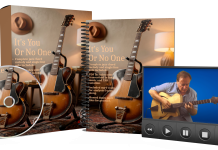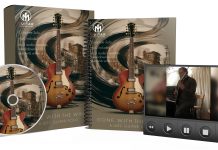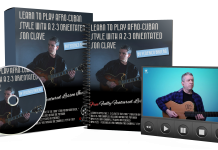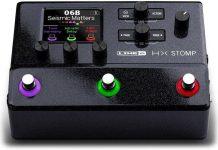This post may contain affiliate links. As an Amazon associate, Google associate as well as associate for other programs, Guitar & Music Institute may earn commissions from qualifying purchases.

Have you ever dreamed of strumming a guitar like the greats, bringing melodies to life with your fingertips? Embarking on your musical journey with guitar lessons for beginners can open up a world of expression and enjoyment you never knew existed. Whether your goal is to serenade a sunset or rock out in your room, learning the first guitar chords is your ticket to an amazing adventure with this versatile instrument.
From gentle ballads to energetic rock anthems, mastering strumming techniques and beginner guitar songs can transform you from an enthusiast to an artist in your own right. It doesn’t matter if it’s the rich warmth of an acoustic melody or the electrifying pulse of an electric guitar riff that calls to you; your journey begins with the basics—and we’re here to guide you every step of the way. Let’s tune into the rhythm and start making music!
Key Takeaways
- Grasp the core of guitar lessons for beginners to set a solid foundation for your musical journey.
- Learn the first guitar chords which are essential building blocks for playing an array of songs.
- Develop strumming techniques to bring rhythm and dynamism to your playing.
- Practice with beginner guitar songs to apply and reinforce your newfound skills.
- Enjoy the process as you join the community of guitar enthusiasts and share your progress and passion.
If you are looking for the very best in print and downloadable publications, then look no further than GMI’s guitar shop. CLICK HERE to view all our free and paid products and courses.
Why not DOWNLOAD a free book of chords, scales and arpeggios for beginners from the GMI Guitar Shop now!
The Mindset for Mastering the Guitar
Embarking on the journey of learning the guitar is an adventure that calls for more than just a passion for music. It demands a particular learning guitar mindset—one where patience and persistence reign supreme. As you delve into the world of strings and notes, recognize that the path to proficiency is paved with consistent, deliberate practice. Guitar practice mentality underscores the value of regular, focused sessions over the occasional marathon that can lead to burnout and frustration.
It’s a common belief that some of the greatest guitarists were born with an innate talent, but behind their seemingly effortless performances are hours of dedicated practice. Many of these artists honed their self-taught guitar skills over time with the understanding that progress is a slow but rewarding process. Your growth as a guitarist isn’t defined by speedy advancement, but by your ability to overcome the inevitable plateaus and challenges along the way.
Envision yourself extracting joy from every chord you strum and every scale you master. It’s not about how quickly you can play a particular song, but how deeply you can understand and feel the music. Avoid the pitfall of comparing your progress to others’, for there will always be someone more advanced and someone just starting out. Rather, focus on your personal achievements and savor the unique sound you create—this is the essence of a fulfilling guitar practice journey.
Essential Basics: Chords, Scales, and Strumming Patterns
Embarking on the journey to master the guitar, you’ll encounter the essential pillars of musicianship: chords, scales, and strumming patterns. Not only do these elements form the foundation of guitar basics, but they also intertwine to create the rich tapestry of sounds recognizable in every song. Whether you’re starting from scratch or refreshing your knowledge, understanding these components is instrumental in developing your guitar proficiency.
Understanding Basic Guitar Chords
As you begin learning guitar chords, familiarize yourself with the shapes and finger positions of major and minor chords, which serve as the backbone for countless songs across all genres. The grip strength and muscle memory necessary to transition smoothly between chords will come with patience and practice. Start with the simplest open chords like G, C, and D, and you’ll be playing along with popular tracks in no time.
Practicing Scales for Finger Dexterity
A focus on guitar scales practice not only enhances your finger dexterity but also equips you with a deeper understanding of music theory. The minor pentatonic scale is particularly beneficial for beginners due to its straightforward pattern and usability in improvisation. Practicing scales is like a workout for your fingers, creating pathways that facilitate effortless navigation of the fretboard.
Mastering Strumming Techniques
While chords and scales are crucial, your playing comes to life through rhythm – enter strumming patterns for guitar. Developing a consistent strumming technique allows you to inject personality into your playing. Focus on maintaining a steady rhythm, and embrace the individual percussive sound each strum brings. Experimenting with various strumming patterns not only broadens your repertoire but also ensures you’re ready to tackle any musical challenge.
With dedication to these guitar essentials, you will soon find yourself making beautiful music, and the sounds of your progress will be the ultimate reward for your efforts. Remember, each chord shape, scale, and strumming pattern brings you a step closer to fluency in the language of music.
The Power of Systematic Practice
Embracing systematic guitar practice can significantly enhance your journey in learning guitar efficiently. Like the guitar legends who’ve carved out timeless riffs and solos, a carefully structured guitar workout is paramount to your success on the six strings. It’s not just about strumming chords or running scales, but about the methodical approach that weaves these skills into your musical tapestry. Imagine laying down a solid rhythm, accurate fingerpicking, and soulful solos—all these are attainable through disciplined practice.
As you chart your course through melodies and harmonies, consider your practice sessions as a sort of musical laboratory. Here, you can experiment, explore, and refine your skills. But be wary, for without a plan, even the most passionate guitarists can go astray. Begin by setting attainable goals; perhaps mastering a particular chord progression or nailing a solo section of your favorite song. With each step forward, celebrate your achievements, no matter how small they may seem. This is the crux of learning guitar efficiently—a steady progression through incremental challenges, polished through repetition and patience.
Let’s not overlook the role of consistency in your practice routine. The adage ‘practice makes perfect’ holds a grain of truth, though it should be tempered by the adage ‘perfect practice makes perfect’. By systematic guitar practice, you align your efforts with progress, ensuring that each strum, each fretted note, leads you closer to your ultimate goal: guitar proficiency. So, tune up that guitar, draft your plan, and embark on a structured quest for musical mastery.
How To Play Guitar: Crafting Your Practice Routine
Embarking on the journey of learning to play guitar is thrilling, and the cornerstone of progress lies in crafting a guitar practice routine that suits your lifestyle and musical ambitions. Having a well-structured plan not only helps you improve your skills, but also ensures that you remain engaged and inspired throughout your learning process. Let’s delve into how setting musical goals and fostering consistent practice habits can elevate your guitar proficiency.

Setting Goals and Tracking Progress
Having a clear vision of what you want to achieve can be incredibly motivating. Start by setting musical goals that are specific, attainable, and tailored to your current level of expertise. These could range from mastering a challenging piece of music, improving a particular technique, or even preparing for a live performance. Utilize guitar practice tracking tools like journals or apps to document your progress, which will help you stay on course and recognize the milestones you’ve achieved along the way.
Creating a Consistent Practice Schedule
Consistency is key in developing any skill, and learning guitar is no different. Creating a consistent practice schedule will help you make steady progress and reduce the likelihood of burning out. Aim to practice at the same time every day, and break down your sessions into focused intervals. Remember, quality trumps quantity, so it’s more beneficial to engage in shorter, productive practices rather than infrequent marathons. By faithfully adhering to your routine, you’ll be rewarded with a growing repertoire and improved technique, making each session a step closer to guitar mastery.
Nurturing Patience in Your Guitar Journey
When embarking on the path to learning guitar, one of the most essential attributes you can possess is patience in guitar learning. It’s not just about practicing relentlessly, but also about practicing wisely. The truth is, no legendary guitarist reached their peak overnight. Instead, it was their ability to maintain persistence in guitar practice that ultimately propelled them to greatness.
Imagine each chord you struggle with today becoming a note in a melody you’ll play effortlessly tomorrow. Persistent guitar practice beats at the heart of this transformation. By recognizing that each day you pick up your guitar, you edge closer to your goals, you’ll find the motivation to continue even when progress seems faint.
Bear in mind that each minute spent mastering a scale, refining a chord transition, or perfecting a strumming pattern contributes to your musical journey. Encourage yourself by celebrating the small victories, the incremental improvements that may seem insignificant but are far from it. These moments are the building blocks of skill and confidence on the guitar.
Perhaps the most crucial insight is to understand that the journey itself is rewarding. The sound of music created from your own hands is a testament to your dedication. Embrace the process, allow time to be your ally, and let patience guide you to a fulfilling expression of your musical passion. After all, the guitar is not just an instrument—it’s a companion on a voyage of continuous discovery and delight.
Overcoming Comparison: Focus on Your Own Growth
Embarking on the journey of personal guitar growth means embracing your unique path and eschewing the trap of comparison. Every guitarist has a distinct story, and each fret pressed is a reflection of their individual journey. While it can be tempting to look at others and measure your progress against theirs, true artistry comes from within. It’s about overcoming guitar player comparison and zeroing in on your personal evolution.
Documenting guitar progress is more than a practice; it’s a powerful tool for motivation and self-reflection. When you record your playing, you’re capturing more than just notes; you’re charting the course of your improvement over time. This tangible evidence of your dedication to the guitar can be an invaluable asset when it comes to staying the course.
Recording and Listening to Your Playing
Imagine being able to track your guitar journey with the same precision as a seasoned navigator charting a voyage across the oceans. Your progress, captured in audio form, serves as a series of waypoints that reflect the distances you’ve crossed in skill and confidence. As you go back and listen to these aural snapshots, notice the subtle — and sometimes not so subtle — evolution in your playing. These recordings are less about producing flawlessly polished tracks and more about highlighting your dedication to growth.
Milestones: Celebrating Your Improvements
Each new chord mastered, each song memorized, and each successful performance are milestones in your guitar journey. Celebrate them. They’re not mere steps on a path, but leaps towards realizing your dream of becoming proficient with the six-stringed companion you’ve chosen. This celebration is a form of acknowledgment, not just for what you’ve achieved but also for your commitment to the process.
Remember that personal growth as a guitarist isn’t linear. It has its highs, lows, and plateaus, which is why marking and rejoicing in your growth is so crucial. Your milestones are unique to you, and they deserve their own ovation. So, every time you reach a new peak in your playing, take a moment to appreciate how far you’ve come from the day you first picked up the guitar.
Let this visual representation of your efforts serve as a beacon; one that not only illuminates your past achievements but also casts light on the exciting road that lies ahead. As you continue to work towards your musical aspirations, remember that your personal guitar growth is the most authentic song you’ll ever play.
Importance of Starting with Scales
Embarking on your guitar journey, you’ll soon discover the importance of guitar scales. These patterns are not just exercises for your fingers; they form the building blocks for all guitar music. Starting with guitar scales for beginners is akin to learning the alphabet before you start to read and write – it’s foundational. The A minor pentatonic scale, known for its simplicity and versatility in rock music, is a great place to begin.
Why are scales so crucial, you might wonder? Mastering them early on simplifies learning guitar in remarkable ways. They improve your finger dexterity, making the complex world of chords and melodies more approachable. Not only do they equip you to pick up songwriting quicker, but they also deepen your understanding of music theory, enabling you to improvise and express yourself more fully through your instrument.
As you dive into scales, remember they are more than mere exercises. They are your secret weapon in developing a fluency with your guitar that will pay dividends for years to come. So, embrace the importance of guitar scales, and let them guide you smoothly into the realm of harmonies and solos that define the music you love.
Implementation: Applying Techniques to Songs and Genres
As you delve deeper into the realm of guitar playing, it’s time to transition from the rudimentary exercises to applying guitar techniques in actual music. Think of each song as a project, your personal workshop where every chord and melody helps in cementing what you’ve practiced into something tangible and melodious. This is where the real fun begins, as you start to see your efforts bear fruit in the form of music that resonates with you and others.
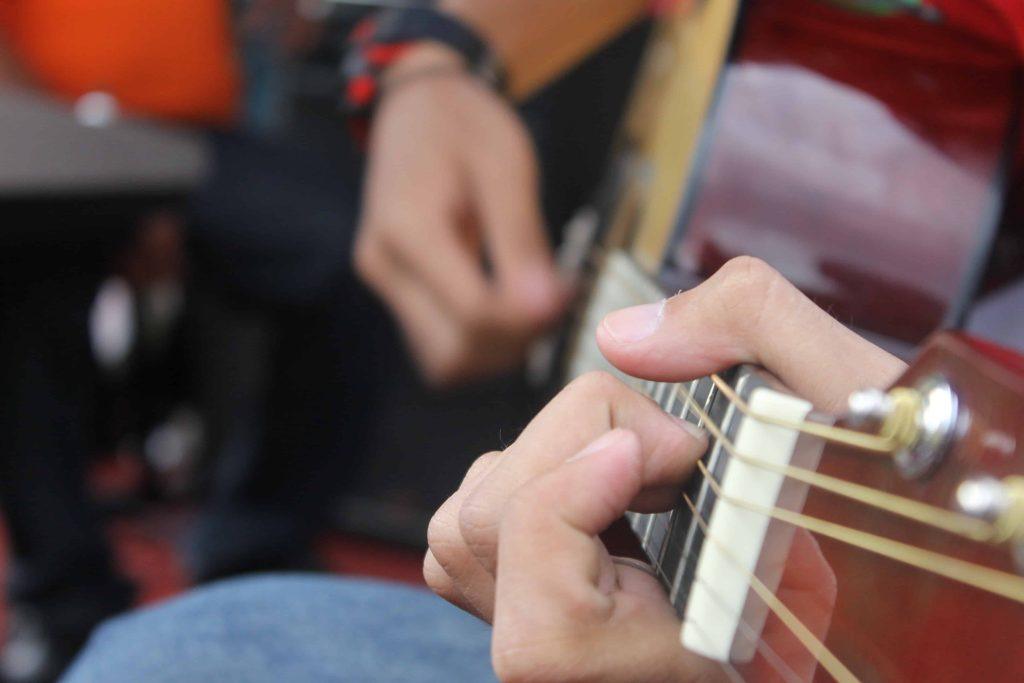
An invaluable method to polish your skills is through song-based guitar learning. Each song comes with its own set of challenges and can serve as a milestone for a particular technique you wish to master. Whether it’s perfecting a tricky solo that improves your fingerpicking or getting the hang of a new strumming pattern, the variety within songs is infinite. This approach not only enhances your technical ability but also naturally boosts your repertoire.
Learning Songs to Improve Technique
Genre-specific guitar practice can lead you through a diverse landscape of music. Exploring genres helps you understand the characteristic techniques that define them, from the soulful bends of the blues to the rapid-fire picking of metal. Every genre has something different to offer, and as you learn songs from a broad spectrum of styles, your ability to adapt and improvise will grow exponentially.
Using Backing Tracks for Real-World Practice
Backing tracks are a guitarist’s best friend when it comes to applying guitar techniques in a context that simulates playing with a band. These tracks can aid in developing your improvisational skills, timing, and musicality. As you practice with these tracks, you’ll learn how to weave in and out of the music, assert your style, and collaborate with the ‘band’ even if it’s just a recording. It’s like having a jam session in the comfort of your own home.
The Art of Staying Motivated and the Pitfalls of Rushing
Embarking on a journey to master the guitar is an admirable endeavor, but in your zeal to progress, it’s imperative to note the importance of staying motivated in your guitar practice without succumbing to the temptations of haste. The excitement to rapidly pick up new songs or techniques can be compelling, yet it often leads to a paradox where eagerness results in setbacks, rather than the intended leap forward. Patience and deliberate practice are your greatest allies in ensuring you build a solid foundation without the pitfalls of rushed learning.
Your journey with the guitar is a personal narrative of growth and self-discovery. Every strum, every chord transition, and every melody learned is a testament to your dedication. Let the thrill of personal progress fuel your practice sessions. When you find yourself grappling with motivation, take a step back to play those favorite songs that once sparked your love for the guitar. It’s a reminder that music is not just a discipline but also a source of joy and expression. This approach helps in avoiding the rush in learning guitar, allowing the complex interplay of notes and rhythms to become second nature over time.
Remember, each challenge faced is a predecessor to potential breakthroughs. As you honor your own pace in this musical voyage, drawing inspiration from guitarists who have trodden this path can provide a sense of solidarity. Balance ambition with realistic expectations, and recognize that the journey to guitar proficiency is not a race but a rich tapestry of experiences that shape your musical voice. Your guitar is not just an instrument, it’s a companion through the ups and downs of learning, always ready to harmonize with your next tune.
Finding Your Unique Sound and Style on the Guitar
When you’re ready to embrace the creative journey of guitar playing, part of the thrill lies in guitar tone exploration. Your venture into finding a unique guitar sound is not just about acquiring skills—it’s about expressing your musical identity.
Exploring Different Guitar Tones
Dialing in the perfect tone is a nuanced art. As you experiment with various amplifiers, effects pedals, and guitar settings, remember that small tweaks can lead to significant changes. These variations in your sound can inspire new directions in your playing and songwriting. Don’t hesitate to take risks and try combinations that might seem unconventional—at times, that’s how new sounds are discovered.
Choosing the Right Guitar for Your Style
Whether it’s a warm, rich acoustic or a crisp, edgy electric, selecting the right guitar is fundamental to your musical expression. The choice of wood, the make of the strings, and the nature of the pickups—all these elements define your instrument’s voice. Venture into shops, play different models, and consult with seasoned players. Their insights, combined with your personal preferences, will lead you to a guitar that feels like an extension of yourself—one that resonates with your style and soul.
Tools and Resources to Aid Learning
Embarking on your guitar learning journey can be an exhilarating experience, and you’re never alone thanks to a myriad of guitar learning tools at your disposal. The digital age has blessed music enthusiasts with an abundance of online guitar resources that make mastering the instrument more accessible than ever. Whether you’re just starting out or honing your skills, educational platforms are valuable assets to add structure and depth to your practice routine.
One of the cornerstones of guitar proficiency is establishing a strong sense of rhythm, for which the classic metronome remains an indispensable tool. In today’s digital iteration, you can find metronomes integrated into guitar learning apps, allowing you to keep time right from your smartphone or tablet. Apps such as Fretello not only bring metronomes into the mix but also offer interactive lessons that are tailored to your current skill level and learning pace.
Moreover, these apps often include extensive libraries of exercises, chord diagrams, and even feedback on your playing, which can be exceptionally valuable for self-directed learners. With the convenience of tracking your progress in real-time, you can ensure that you’re not just playing, but also improving with every strum.
Whether you’re in need of structured guidance or just looking for ways to enhance your current practice routine, these guitar learning apps and resources are your allies. They provide the support, structure, and feedback necessary to empower your self-directed learning path, making your guitar education both effective and enjoyable.
The Role of Community and Learning from Others
Embarking on your guitar learning journey can feel like a solo expedition, but the rise of the guitar learning community has transformed it into a shared voyage. The support and knowledge exchange from like-minded enthusiasts can be a wellspring of guidance and encouragement, breathing life into your musical odyssey.
Learning from Peers and Online Communities
Embrace the power of peer-to-peer guitar learning. Connecting with others through online forums, social media groups, or local clubs, you’re not just exchanging chords and strumming patterns, but building a collective repository of experiences that fortifies your musical foundation. Whether you’re tackling a complex solo or ironing out a tricky riff, someone out there has been where you are now, ready to lend a tip or an ear.
Finding Inspiration from Guitar Heroes
Seeking musical inspiration from guitar heroes is more than just admiring their prowess; it’s learning the narrative of their craft. These legends, with their battle scars and tunes, didn’t simply wake up at the pinnacle of stardom—they practiced, failed, and persevered. Understanding their paths provides not just a motivational soundtrack for your practice sessions, but also a reminder that every master was once a student.
Create the Perfect Practice Environment
Setting up your guitar practice space is more than just finding a corner in your room; it’s about crafting an environment that inspires and fosters musical growth. Your home guitar setup should be a sanctuary where distractions fade away, and focus comes to the forefront. Consider the essentials: comfortable seating that supports a healthy posture, and lighting that’s bright enough to see your fretboard without straining your eyes. Remember, your practice environment setup must serve as an inviting canvas for your daily practice sessions.
Temperature and acoustics also play a role in your comfort and sound quality. A room that’s too cold might make your hands stiff, whereas a room that’s too warm could lead to discomfort. Effective soundproofing can also help you concentrate on your playing and avoid disturbing others. Decorate your practice environment setup with items that motivate you—a poster of your favorite guitarist, a rack of varied guitars, or a shelf of influential albums. Personal touches will make the space uniquely yours and encourage regular visits to your guitar.
Your guitar practice space doesn’t need to be a professional studio. With a thoughtfully-arranged home guitar setup, you’ll be eager to pick up your guitar and play. By creating an environment that is solely dedicated to your musical practice, you’re not only setting yourself up for success but also establishing a personal retreat that will consistently beckon you to refine your craft. So, invest a bit of time to make your space conducive to learning, and it will pay dividends in your guitar mastery journey.
Conclusion
Embarking on the path to learn the guitar is more than acquiring a new skill—it’s a transformative experience that intertwines discipline, creativity, and personal growth. Your journey with the guitar has likely been lined with moments of frustration and elation, each chord and melody a testament to your dedication. As you reflect on your guitar learning reflection, there’s a recognizably profound change in how you approach music and the proficiency you’ve developed. The foundational skills you’ve honed serve not just as a musical toolkit but as a springboard, propelling you to explore the vast landscape of guitar playing.
Reflecting on Your Guitar Learning Journey
Your initial foray into the world of strings and frets—grasping the first guitar chords, the joyful resonance of beginner guitar songs, to the development of strumming techniques—each step has been a building block in constructing your musical identity. A guitar learning reflection is more than a glance in the rearview mirror; it’s an essential process that affirms how far you’ve traveled from the rawness of beginner uncertainty to a level of capability where even your mistakes are infused with intention and knowledge.
Next Steps after Mastering the Basics
Once you are comfortable beyond guitar basics, the real adventure begins. Advancing guitar skills encompasses delving into nuanced genres, perhaps embracing the crisp articulations of jazz or the soulful bends of the blues. The pursuit of developing your unique artistic voice will lead you to experiment with new techniques, lending color and depth to your playing. And as you look towards the road ahead, remember that the journey with your guitar is limitless. Whether it’s sharing your music with the world, joining a band, or writing original compositions, seize the opportunities to continue enriching your craft. By staying curious and adaptable, your guitar narrative will continue to evolve, offering boundless avenues for creative expression and joy.
FAQ
What are the first guitar chords I should learn?
As a beginner, you should start with basic open chords like C Major, G Major, D Major, E Minor, and A Minor. These chords form the foundation for playing a variety of beginner guitar songs and are essential for your practice routine. Download our free book of chords and scales from the GMI Guitar Shop by clicking HERE.
How can I develop the right learning guitar mindset?
Adopt a patient and persistent mindset. Understand that learning to play guitar takes time, and celebrate small victories along the way. Look to self-taught guitar greats like Jimi Hendrix and Eric Clapton for inspiration, and believe in the power of disciplined self-practice.
Why are guitar scales important for beginners?
Scales are important because they improve finger dexterity and teach you the basic building blocks of music. Start with the A minor pentatonic scale, which is foundational for genres like rock and blues and is relatively simple to learn.
What strumming techniques should I start with?
Begin with basic downstroke strumming to get comfortable holding the pick and maintaining a steady rhythm. Once you’ve mastered that, learn alternate down-up strum patterns, and practice with a metronome to develop timing and feel for different musical beats.
How often should I practice guitar to see improvement?
Aim for consistent, focused practice sessions of about 20 minutes, 3 to 5 times per week. Regular practice is more beneficial than occasional longer sessions as it helps build muscle memory and reinforce learning.
How can I craft an effective guitar practice routine?
Set clear, achievable goals for what you want to accomplish, such as mastering a specific chord progression or song. Create a schedule that allocates time to technique, theory, and song practicing and stick to it. Use apps like Fretello to guide your structured practice sessions.
What should I do when I feel stuck or frustrated while learning the guitar?
Stay patient and remind yourself that every guitarist experiences plateaus. Take a break if needed but maintain your regular practice routine. Reflect on your progress, recognize your improvements, and remember that challenges often lead to breakthroughs.
How can I ensure I don’t develop bad habits while learning on my own?
Use online resources and guitar learning tools to guide your practice. Be disciplined about maintaining good posture, hand positioning, and accurate finger placement from the start. Record yourself to identify and correct any issues with technique early on.
Why is recording and listening to my playing important?
Recording your playing helps you track your progress objectively and recognize areas for improvement. Listening back can bring attention to nuances and provide insight into your technique, timing, and overall sound.
How can I use backing tracks to improve my guitar playing?
Backing tracks provide a musical context for applying the scales and chords you’ve learned. They help you practice improvising, develop your sense of rhythm, and enhance your ability to play in harmony with other instruments.
How do I find the right guitar for my musical style?
Consider the genres you want to play and research which types of guitars are commonly used for those styles. Visit music stores to try out different guitars and find one that feels comfortable and suits your tonal preference. Don’t hesitate to ask for advice from more experienced guitarists.
How can I maintain motivation during my guitar learning journey?
Keep your practice sessions interesting by mixing technique exercises with playing songs you love. Set realistic goals and reward yourself for achieving them. Gain motivation by engaging with the guitar community, and draw inspiration from your favorite guitar heroes.
What are the benefits of learning from other guitar players and communities?
Connecting with others can provide support, fresh perspectives, and practical tips. You can learn from the experiences of your peers, share practice techniques, and even find new music or gear recommendations.
What makes a conducive practice environment for learning guitar?
Your practice space should be comfortable, well-lit, and free of distractions. Ensure you have all your essentials at hand, such as a music stand, tuner, and metronome. An inspiring environment that reflects your musical tastes can encourage regular practice.
Source Links
- https://www.fender.com/articles/techniques/best-way-to-learn-guitar
- https://fretello.com/news/learn-guitar-efficiently/
- https://masonmusic.com/6-tips-beginner-guitar/
This post may contain affiliate links. As an Amazon associate, Google associate as well as associate for other programs, Guitar & Music Institute may earn commissions from qualifying purchases.







